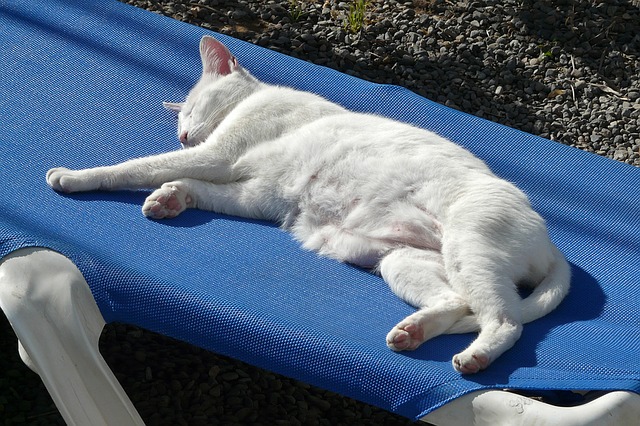News & Special Offers

The importance of protecting white dogs and cats from sunburn
Like humans, dogs and cats are susceptible to sunburn. The ultraviolet radiation which forms part of the sun’s rays can cause immediate and long term damage to our furry friends. This damage can be minimised, or even prevented, by a prepared owner.
Do all cats and dogs get sunburnt?
All animals can suffer from sunburn. Some breeds and colours of pets are more predisposed. Animals with white hairs and pink skin are more likely to get burnt because less melanin is produced than in darker coloured skin. Melanin helps to protect the skin from the damage the sunlight can do to DNA; white hairs and pink skin allow more of the harmful UV radiation to reach the sensitive layers within the skin.
Sunburn frequently affects specific areas of the body allowing us to do more specific checks on our pets. These areas are often less covered in hairs and include the ears, eyelids, belly and especially the nose. The hairs normally provide protection from the sun, so the fewer hairs the less protection. If your pet moults irregularly and has bald patches, these may burn quickly too.
How do I know if my pet is sunburnt?
In many cases, their behaviour may change. They may become lethargic, agitated and less willing to play. They may become more irritable and appear uncomfortable. Your pet’s skin will appear red, although this is sometimes hard to see due to the fur covering the skin. If severe, blistering can occur on the surface of the skin. It is important not to pop these blisters as this can lead to infections. In milder cases, the skin may dry out and look flaky to the naked eye as the top layers of skin fall off. Your pet may resist touching of the area or cry out due to it being sore – so avoid touching it unless you are treating it.
Why should I protect my pet from the sun?
Excessive sun can cause damage to your pet’s body. The sun is incredibly powerful and dangerous. It has the capability to alter the DNA, the blueprint for life, inside their cells!
Discomfort – your pet may have very red, sore skin. If they scratch these burns and they become open wounds, they are then susceptible to infection. These infections vary in severity and could be caused by many microorganisms. These wounds may get very itchy.
Blistering – blisters often form on the surface of the skin. These can pop prematurely and become infected too.
Dehydration and heatstroke – sunburn is normally seen alongside dehydration and even heatstroke. Signs include vomiting and diarrhoea, severe panting, weakness or wobbliness, dark gums and eventually even collapse and death.
Cancer – there are many different skin cancers which can form due to excessive sunlight, including basal cell carcinoma and squamous cell carcinoma. These skin cancers can be fatal as some have the ability to metastasise (spread) and form secondary tumours elsewhere. Many appear first as small non-healing ulcers, but some may form more characteristic “lumps” in the skin. While often treatable if caught early, skin cancers in pets can be highly malignant and life-threatening.
How can I protect them from getting sunburnt?
You should always offer shade to your pet when taking them on days out. If your pet enjoys being outside, you should place their water and bed in the shade to encourage them to stay in these areas. Reducing the amount of time your pet spends in the intense sunlight is the most effective way to minimise the risk of sunburn!
You can also get sun cream for your pets. This should be applied to the susceptible areas and reapplied throughout the day. Buy the water-resistant suncream. Be aware that if your pet rubs its body along objects or other animals, the creams will need to be applied more often. Applying the suncream early is very important as, once the sunburn has happened, many cats and dogs become irritated if the sore area gets touched making applying suncream more of a challenge.
What shall I do if my cat or dog gets sunburnt?
Rehydration is key. This can be done by encouraging them to drink from a water dish but if dehydration is severe, the cat or dog may need to be given fluids intravenously at the vets. Dehydration can be a cause of death so it is vital this hydration status is reversed.
The sore wounds need to be kept clean. You can apply antiseptic cream and keep the wounds covered until a solid scab has formed over the top, but it’s best to talk to one of our vets before choosing an ointment. Some are less effective – and less safe – than others.
Be aware that even after your pet has been moved out of the sunlight, the sunburn will still feel very warm and be tender to touch. Behavioural symptoms may last multiple days or weeks until the pain has disappeared.
Worried about your pet? Give us a call for advice!
